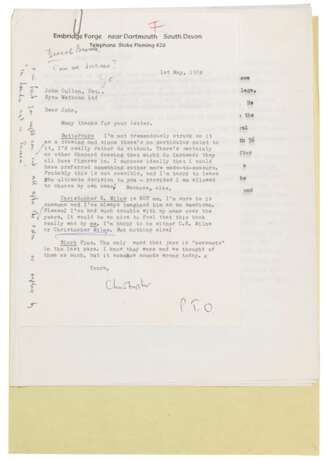Christopher Robin Milne (1920-1996) and Ernest Howard Shepard (1879-1976)
28.04.2021 11:00UTC +00:00
Classic
Verkauft
1250GBP £ 1 250
| Auctioneer | CHRISTIE'S |
|---|---|
| Veranstaltungsort | Vereinigtes Königreich, London |
| Aufgeld | see on Website% |
Archiv
Die Auktion ist abgeschlossen. Es können keine Gebote mehr abgegeben werden.

ID 519306
Los 17 | Christopher Robin Milne (1920-1996) and Ernest Howard Shepard (1879-1976)
Schätzwert
£ 1 500 – 2 500
A collection of letters sent to the publisher Methuen, 1969-1990.
Christopher Milne (1920-1996). 32 typed letters signed, nine autograph letters signed and one autograph note signed (‘Christopher Milne’, ‘C.R. Milne’ or ‘Christopher’) to John Cullen and three further Methuen employees, Embridge Forge, near Dartmouth or the Harbour Bookshop, Dartmouth, 7 July 1973 to 21 July 1990.
Various sizes, chiefly 210 x 150mm or 253 x 203mm, 49 pages in total, autograph additions and emendations, annotations by John Cullen or other Methuen employees scattered throughout [With:] copies of Methuen outgoing correspondence, chiefly from John Cullen, a number of annotated typed page drafts for The Enchanted Places and related material including proof dust-jackets.
A correspondence charting the genesis of The Enchanted Places, Christopher Milne’s memoir of his childhood, offering a fascinating insight into the ambiguous relationship he had with the literary legacy created for him by his father and his preoccupation with what the public expected of ‘Christopher Robin’.
Christopher Milne first wrote to John Cullen, latterly his editor at Methuen, to ask if the publisher would be interested in a memoir of his childhood, explaining: ‘From time to time I get asked questions about the Pooh books and about my childhood, and mostly I flinch from them. But towards the end of last year I felt that the time had come and I was quite old enough to stop flinching and start answering’ (7 July 1973). The correspondence that follows – which survives here as a discrete collection along with Cullen’s copy outgoing – charts the progress of the book towards publication, as Milne attempts to reconcile his ideal manuscript with what he imagines the public wants to know of him and his famous father: ‘My difficulty has been that what (I imagined) the reader wanted to read and what I enjoyed writing were two rather different things. The reader was interested in Christopher-Robinny things. I was not. I found them embarrassing. [The format I have chosen] means I can leave out anything I don’t want to say without there being an obvious gap. It means that I don’t have to attempt to answer the question “What sort of man was your father?”, but can merely say: “He did such and he did such” and leave it to the reader to add it all together and work out his own answer’ (2 August 1973). Milne is persuaded by his publisher that the book should include photographs – he asks that his Nanny might write the captions – and there is discussion of suitable dust-jacket designs and how far these might lean upon E.H. Shepard’s illustrations for the Pooh books: ‘Poohs and Piglets all over the place would be doing it in the wrong sort of way’ (7 February 1974). Milne initially suggests that the title of the book should make reference to his somewhat difficult relationship with the name ‘Christopher Robin’ – ‘it seemed that the word ‘name’ ought to be there [e.g.] “What’s in a Name”’ (5 February 1974) – before settling on The Enchanted Places, which ‘comes (as I think it should) from the last para in House at Pooh Corner’ (10 April 1974). Further insights into the private character of A.A. Milne’s only son are scattered throughout the correspondence – in a letter from 1 May 1974 he writes with some emphasis ‘Christopher R. Milne’ is NOT me. I’m sure he is someone and I’ve always imagined him as an American. Please! I’ve had such trouble with my name over the years. It would be so nice to feel that this book really was by me’; the later letters deal with further editions and, eventually, Milne’s retirement.
[And:]
Ernest Howard Shepard (1879-1976). Four autograph letters signed (‘E.H. Shepard’) to John Cullen, Woodmancote, Petworth, 5 November 1969 – 10 December 1960.
4½ pages in total. Chiefly in relation to a lunch given by Methuen in his honour: ‘I think the last time I visited the Garrick Club was at a lunch given by E.V. Lucas, when I sat next to a famous playwright […] There is only one food my wife cannot bear – Tapioca pudding’ (17 November 1969).
| Adresse der Versteigerung |
CHRISTIE'S 8 King Street, St. James's SW1Y 6QT London Vereinigtes Königreich | |
|---|---|---|
| Vorschau |
| |
| Telefon | +44 (0)20 7839 9060 | |
| Aufgeld | see on Website | |
| Nutzungsbedingungen | Nutzungsbedingungen |


